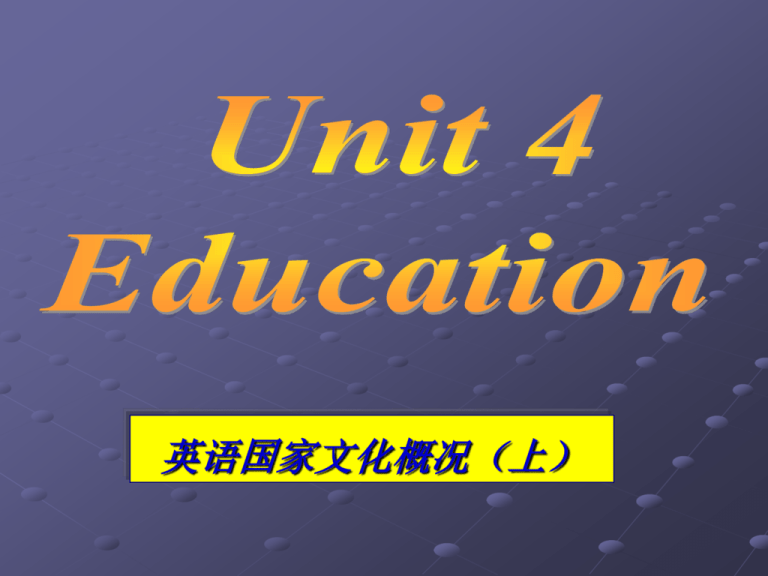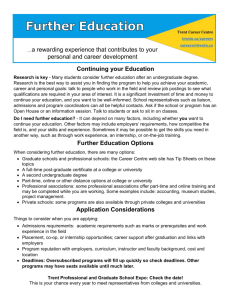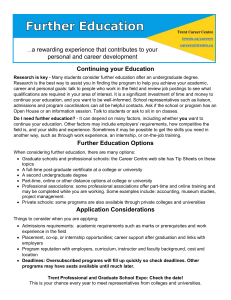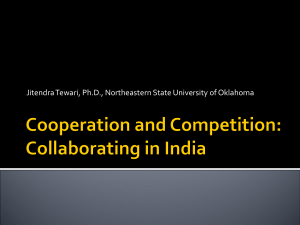Text B: Higher education in UK
advertisement

英语国家文化概况(上) Focus Section A: Education System Section B: Top schools and Universities Section C: Oversea students Discussion Before Reading Why do people study abroad? Do you desire to study abroad? If so, why? Do you need to learn about Western education? Why or why not? What are the advantages of American education system that have taken place in a) primary schools, b) secondary schools, and c) higher education? Guess Before Reading 1. What percentage of British pupils receive free education from the public schools? _____ 53% ______ 83% _______ 93% 2. How long do most undergraduate degrees take to complete in Britain? ______ 3 years _______ 4 years _______ 5 years 3. Who are responsible for American public schools? _______ the federal government _______ the 50 state governments 4. Which is the oldest university in the US? _____ Oxford ______ Harvard ________ Yale Section A: Education System 4.1 The UK 4.2 The US 4.3 Canada,Australia and New Zealand 4.1 The UK Text A: Compulsory education in the UK Text B: Higher education in the UK Text C: Types of degrees Text A: Compulsory education in the UK Education System in the UK is compulsory. Children are legally obliged to attend school from the ages of 5 to 16. Parents can choose between sending their children to state schools or to private schools. State schools are funded by local and central government. Cultural Notes: state schools 国立学校, 与之相对的是private/ independent schools 又称 public schools公学。私立 学校 除部分政府财政资助外,主要通过学生学费 筹集经费。因此,学费较高通常为富贵家庭的子弟 就学。 Text A: Compulsory education in the UK About 93% of pupils receive free education from the public schools. Government also sometimes assists schools established by religious groups. Between the ages of 5 to 11, pupils mainly attend state sector primary schools. These schools are called mixed schools for they admit both boys and girls. Text A: Compulsory education in the UK From the age of 11 up to around the age of 19, students attend secondary schools. About 90% of secondary schools are comprehensive schools which admit children without reference to their academic abilities. Such schools provide a general education. Pupils can study everything from academic subjects like literature and sciences, to more practical subjects like cooking and carpentry. Foreign languages are taught as a part of the National Curriculum, reflecting the importance of Britain’ s relationship with Europe. Text A: Compulsory education in the UK Those children who do not attend comprehensive schools attend grammar schools instead. Grammar schools select children usually at the age of 11, through an examination called “the 11-plus”. Those who show academic potential are admitted to the grammar schools where the emphasis is on advanced academic work rather than the more general curriculum of the comprehensive schools. Cultural Notes: 11 Plus:十一岁时学生一般参加11 Plus(11加) 考试,内容包括英语、数学和智力。通过者可以 进入文法学校(Grammar School),并能进入大 学深造;落榜者只能进入技工学校或一般中学学 习,不能进入大学深造。现在,越来越多的人呼 吁给学生提供平等的机会和更多的选择,因此, 90%的学生都能进入综合性中学,学习一段时间 之后再依具体情况决定自己的选择。 Text A: Compulsory education in the UK At the age of 16, British children take General Certificate of Secondary Education (GCSE) examinations. Then they can quit school or prepare to sit university entrance exams. Those who hope to attend university carry on their academic study in the 6th form for another two years and then sit A-levels exams or concentrate on vocational training for GNVQ (General National Vocational Qualifications), the vocational equivalent of A-levels. Cultural Notes : A-levels exams:高级水平测试结业证书, 即英国的“高考”,像剑桥、牛津这样一 流的大学,通常要求考生至少拥有3门A等 的A-LEVEL考试成绩,才有资格被录取; 有些系科和专业要求更高。 Text B: Higher education in UK There are policies to encourage all 16- and 17year-olds to continue their education or training at university or other higher education institutions. Text B: Higher education in UK Approximately 1.8 million students currently are in the higher education system; about one third of young people go on to higher education at age 18, and an increasing number of "mature" students are studying either full-time or part-time for university degrees. Text B: Higher education in UK Most undergraduate degrees take three years to complete. At the graduate level, a taught master's degree normally is earned in a single year, a research master's takes two years, and a doctoral degree is completed after three years. Professional courses usually are undertaken as five-year undergraduate degrees. Text B: Higher education in UK There are 110 universities in UK. 93 in England, 13 in Scotland, 2 in Wales and 2 in Northern Ireland. Over 42% of pupils become university students on leaving school at 18. Two other main universities. University of Buckingham (private); Open University. Text B: Higher education in UK There is only one privately funded university: the University of Buckingham Open University Open University was founded in Britain in the 1960s for people who may not get the opportunity for higher education for economic and social reasons. It's open to everybody and does not demand the same formal educational qualifications as the other universities. University courses are followed through TV, radio, correspondence, videos and a network of study centers. At the end of their studies at the Open University, successful students are awarded a university degree. Text C: Types of degrees Undergraduate Types of undergraduate degree include: BSc (Bachelor of Science) - a science degree BA (Bachelor of Arts) - an arts degree BEng (Bachelor of Engineering) - an engineering degree Undergraduate Masters degree - an enhanced four year undergraduate degree including extra subjects studied at a deeper level. Text C: Types of degrees Postgraduate Students who receive good grades in their undergraduate degrees may choose to take a Masters degree, which takes a minimum of one year to complete. Types of Masters degree include: MSc (Master of Science) MA (Master of Arts) MEd (Master of Education) LLM (Master of Law) MBA (Master of Business Administration) Text C: Types of degrees Taught Masters degrees Taught Masters usually involve six months of intensive tuition followed by six months of project work which ends with a dissertation. Text C: Types of degrees Masters degrees by research Research degrees involve at least one year, sometimes more, of full-time research resulting in an examined thesis. Text C: Types of degrees PhD If you would like to continue to study for a PhD, you will have to conduct a minimum of two years' research after the award of your MSc. In some subject areas, a student may transfer from BSc/BA/BEng to PhD so that they follow a three year research program for PhD without first obtaining a Masters degree. 4.2 Education System in US Text A: The first 12-year education Text B: Higher education in the US Text C: Undergraduate and Graduate Text A: The First 12 Years Most Americans attend twelve years of primary and secondary school. Primary and Secondary School begins around age six for U.S. children. They attend five or six years of primary school. Next they go to secondary school. Text A: The First 12 Years In primary school, Academic subjects include language arts such as reading, writing, spelling and penmanship,mathematics, science, physical education and social studies (mostly history and geography). Social studies emphasize the multi-cultural nature of the US. Subjects are more specialized in high school than in elementary school. Text A: The First 12 Years The typical school day is about 6 hours long and ends about 3:00 P.M. Classes are given Monday through Friday. The school day is very busy and very long for many high students. Many take five or six major academic subjects as well as physical education. Text A: The First 12 Years During other periods, students may be doing homework in a study hall, researching in the school library, or participating in activities such as student government, school newspaper or math club, helping students find friends with similar interests, develop their talents, gain self-confidence and sometimes even discover their career goals. Students’ Activities in schools Text B: Higher Education in US Higher education in the United States is quite various from one state to another. It is characterized by competition and autonomous institutions of higher learning. Colleges and universities Two-year institutions Four-year institutions Community colleges Text B: Higher Education in US The first two years of college are called the "freshman" and "sophomore" years. Students in the first year are called "freshmen," and they are "sophomores" in the second year. Some schools require freshmen and sophomores to take courses in different areas of learning: literature, science, the social sciences, the arts, history, and so forth. Text B: Higher Education in US The "junior" and "senior," or third and fourth years, are the "upper classes." When they enter their junior year, they must choose a "major" field of study. They must take a certain number of courses in this department, or field. In some schools, students also choose a "minor" field. There is usually time for students to choose several other "elective" courses in other subjects. Text B: Higher Education in US faculty advisor who teaches courses in the student's major field. This advisor helps the student select a program of study. Transfers: If a student enrolls in a new university before finishing a degree, they can transfer to another university and still graduate within a reasonable time. Credits: Each course is considered to be worth a number of "credits" or "credit hours." Text B:Higher Education in US Classroom learning: Classes range from large lectures for several hundred students to smaller classes and "seminars" with only a few students. Marks are based upon Classroom participation. Discussion, questions, conversation; Students are expected to participate in class discussions, especially in seminar classes. A midterm examination is usually given during class time. Final examinations are held some time after the final class meeting. Text C: Undergraduate and Graduate The typical academic degree earned by American students is the "Bachelor of Arts" (BA) or the "Bachelor of Science" (BS). These degrees are awarded following the completion of four years of studies. In the first two years of their studies, American students take a number of required courses in general subject areas. After the second year, American students take a major, and spend the remaining two years taking courses in these academic disciplines. After having earned the "bachelors," most Americans end their "academic careers" and look for jobs. Text C: Undergraduate and Graduate Those who decide to pursue their education further can earn a Master of Arts or Master of Science, respectively, in one to two years. These so-called "Master's Degrees" are offered only at universities, and not at colleges. Likewise, only universities offer professional degrees, as for example the Juris Doctor (for law), the Doctor of Medicine (for medicine), and the well-known Master of Business Administration, or MBA. It usually takes two to four years to complete these professional degrees. Text C: Undergraduate and Graduate Earning a doctorate (Doctor of Philosophy, or Ph.D.) in the United States takes between four and six years. The first phase of one's doctoral studies usually lasts two years and is concluded with an extensive examination in all the subject areas studied until that point. This examination is known as the "preliminary examination" or alternatively as the "qualifying examination." Following the successful completion of this examination, the student may begin his research for his doctoral dissertation. 4.3 Education in Canada, Australia and New Zealand Text A: Canadian education Text B: Australian education Text C: Education in New Zealand Text A: Canadian Education The education system in Canada encompasses both publicly funded and private schools, including community colleges/ technical institutes, career colleges, language schools, secondary schools, summer camps, universities and colleges. Children Attend Kindergarten for one or two years at the age of 4 or 5 and begin Grade One at about six years of age. Secondary schools go up to Grade 11 or 12. The school year normally runs from September through the following June but in some instances, January intake dates are possible education between high school and university. Text B: Australian Education Each state and territory in Australia independently runs their own form of education from grades 1-12. Primary Schools: kindergarten or grade 1 to grades 6 or 7. Secondary High Schools: grades 7 or 8 to grade 12. Three main types of schools in Australia, public schools, non-religious private school and religious private school. Most public schools have co-education. The final result is taken from the student's overall performance in all exams throughout grades 11 and 12. Text C: Education in New Zealand Courses are available for academic, professional and vocational studies at universities, polytechnics, colleges of education, secondary schools and private training establishments. New Zealand secondary schools provide a sound education to students aged 13-18 years. Some schools have classes for students aged 11 and 12 as well. Most secondary schools are government-established. Some international students select one of the foundation programs that are offered around New Zealand to directly prepare students for university study. Section B: Top Schools and Universities 4.4 The UK 4.5 The US 4.6 Canada,Australia and New Zealand 4.4 The UK Text A: The University of Oxford Text B: The University of Cambridge Text C: The University of London Text A: The University of Oxford Oxford is the oldest university in the Englishspeaking world, an internationally renowned center for teaching and research. It lies about 57 miles north-west of London. Oxford attracts students and scholars from across the globe, with almost a quarter of our students from overseas. Text A: The University of Oxford Oxford is a collegiate university. It has 39 selfgoverning colleges related to the University. There are also seven Permanent Private, founded by different Christian denominations. Thirty colleges and all halls admit students for both undergraduate and graduate degrees. Seven other colleges are for graduates only; one has Fellows , graduate students holding fellowships only, and one specializes in part-time and continuing education. Text A: The University of Oxford Oxford offers undergraduates a unique learning experience through the tutorial system, in which students meet regularly with their college tutor, either on a one-to-one basis or with one or two other students, as an integral part of the pedagogic mix. Graduate students make up more than a quarter of the total student body. The University offers a wide range of taught graduate and research degrees, ranging from one to three or more years in length. Text B: The University of Cambridge University of Cambridge, located in the United Kingdom, is one of the top universities of the world. It has given many great philosophers and Noble Prize winners to the mankind. The University of Cambridge is a confederation of Colleges, Faculties and other institutions. Text B: The University of Cambridge The University provides a wonderful learning experience and offers opportunities for broadening the experience of students and staff through participation in sport, music, drama, the visual arts, and other cultural activities. Text C: The University of London The University of London is a federal university and is one of the oldest, largest and most diverse universities in the UK. It consists of 19 self-governing Colleges of outstanding reputation and a number of other central academic activities. 4.5 the US Text A: Harvard University Text B: Massachusetts Institute of Technology Text A: Harvard University Text A: Harvard University Harvard University was founded in 1636. It is the oldest university in the USA, and is renowned all over the world for its academic excellence. Harvard University has produced about 40 Nobel winners in different academic fields so far. Harvard University comprises the undergraduate college, the graduate schools, other academic bodies, research centers and affiliated institutions. Harvard University admits students in its extension school also. Text B: Massachusetts Institute of Technology Massachusetts Institute of Technology (MIT) ranks among the best universities in the world. MIT consists of five schools, namely, School of Architecture and Planning, School of Engineering, School of Humanities, School of Management, School of Science and the College of Health Sciences and Technology. Text B: Massachusetts Institute of Technology As a top ranked educational institution, MIT is independent, and privately endowed. Through its five schools and one college that encompass 34 academic departments, divisions and degree granting programs as well as numerous interdisciplinary centers, laboratories and programs. MIT is committed to provide all its students a strong scientific, technical, and humanistic foundation and encouraging them to develop creativity in defining problems and seeking solutions. 4.6 Canada, Australia and New Zealand Text A: Concordia University Text B: University of Canberra Text C: University of Auckland Text A:Concordia University Concordia University in Montreal, Quebec, is a large, urban, English-language institution with academic roots going back over 150 years. Its wide range of programs, both full-time and parttime, provide a unique and challenging educational experience. It offers more than 250 undergraduate and graduate programs through its Faculties: Arts and Science, the John Molson School of Business, Engineering and Computer Science, Fine Arts and the School of Graduate Studies. Text B: The University of Canberra The mission of the University of Canberra is to provide the highest level of professional undergraduate education in Australia. It educates students for approximately 30 different professions, among them information technology, management, law, design, architecture, biomedical science, psychology, accounting, engineering, teaching, modern languages, marketing, journalism, nursing, environmental science and sports studies. UC has one of the highest employment rates for graduates in Australia. Text C: Auckland University The University is centrally located in the cosmopolitan city of Auckland, providing an exciting, stimulating environment for over 40,000 students. The University enjoys international status as the only New Zealand university invited to join Universitas21 and the Association of Pacific Rim Universities. Section C: Overseas Students 4.7 Study in the UK 4.8 Study in the US Text A: Application and Qualification International students are welcome in all four parts of the UK: England, Scotland, Wales and Northern Ireland. Each of the four countries has broadly the same structure of education, and broadly the same sort of educational institutions. Text A: Application and Qualification A-levels and AS-levels are still the most common entrance qualifications for students in the UK though the most universities and university sector colleges now accept the IB and GNVQs as the equivalent of A-level. If you have not been educated in Britain, you will need to check the level you have reached corresponds to the British system. GNVQ(General National Vocational Qualification) 全国通用职业资格. Text A: Application and Qualification Another factor that will influence your application will be your level of English. All colleges will require a certain level of English competence, depending on the type of course applied for, and will test for English ability either in your own country or on arrival. Most institutions offer language support to international students alongside their educational course, as well as professional English programs. 4.7 Study in the US Text A: When to Apply Text B: Choosing a School Text C: Financial Issues Text D: Study as Americans Students Do Text A: When to Apply Successful applications for international students to a top school in these two countries require preparation. The admission process is a long one, and should ideally begin at least 18 months before your expected arrival in the US. Organization and planning are very important because timely completion of all the necessary steps is key. Text A: When to Apply 18 months before: Begin your search of possible US colleges or universities that you would like to attend. Register and start preparing for the TOEFL and other entrance tests such as the SAT or GRE. 15 months before: Take the TOEFL and other entrance tests. 12 months before: Send letters to colleges you have selected requesting applications and information, or obtain this information and necessary forms from their websites. 11 months before: If you have not yet received the application forms you requested from the schools you wrote to, send another letter repeating your request. Cultural Notes: TOEFL(Test of English as a Foreign Language) 是 由美国教育考试服务处ETS (Educational Testing Service) 举办的,为申请去美国或加拿大等国家上 大学或入研究生院学习的非英语国家的学生提供 的英语水平考试。 GRE是Graduate Record Examination的缩写,美国 研究生入学考试资格考试。美国大学研究生院规 定:申请攻读硕士和博士等高级学位的人员必须 参加这项考试。 GRE由美国教育考试服务处ETS 主办。 Text A: When to Apply 10 months before: Complete your essays and application forms, including the financial aid application forms, using the originals. 9 months before: Respond to any requests you receive schools to request more information or resubmission of something you have already sent. 4-5 months before: Hear decisions from the schools and contact the admissions office at any school that you do not hear from and let the other schools know of your decision. 3 months before: Get a visa application form from the US embassy or consulate nearest you. Make travel arrangements. Schedule your trip so you arrive at least 15 days prior to your school. Text B: Choosing a School American education offers a rich field of choices for the international student. From abroad, and even from within the U.S.A., there is such an array of institutions, programs and locations that the choices may overwhelm the student. To simplify the choices, a student must carefully study how each program and location can fulfill the student's goals. Text B: Choosing a School In order to make informed decisions, a student will need to know how the U.S. education system is organized. State College or University Private College or University Two-Year College Community College Professional School Institute of Technology Technical Institute Church-related School Text C: Financial Issues The immediate problem that a Chinese student would encounter upon arriving in the U.S. is how to pay for the tuition and living expenses. By your intelligence and diligence you get financial support and make money to live on. In the U.S. foreign students without “green card ” are not allowed to find jobs outside the campus, but they can find their way doing some campus-jobs as librarian, office worker, building cleaner, etc, which usually require a lot of tome with low pay, and they do not relate in any sense to your studies. Text C: Financial Issues The ideal way is to get a position of Teaching Assistantship (T.A.) or Research Assistantship (R.A.) offered by the university. By your teaching work or research work you can have a monthly pay. If you are outstanding in your studies, you can get scholarship granted by the university or association. The applicants for T.A. or R.A. are limited to graduate students. Once you get such a position, there is no guarantee that you will keep it forever. If you do not have a good work performance, you will be discharged from the position. Text D: Study as American Students Do It is important for the Chinese students studying in the United States to foster their own ability to think independently and make a decision independently. In American universities, classroom work usually contains a lot of questions and answers, academic seminars, topic discussions and reports. Text D: Study as American Students Do Practical orientation to master a useful practical skill. The courses are with heavy assignments, and some of them require a lot of time in the computer lab. Some other courses, especially in the graduate programs, are designed to train students to think creatively, to analyze independently, and to provide their own solutions to problems. Text D: Study as American Students Do These courses emphasize your approach, or the research methodology, not the correctness of your solution. A single correct answer might not even exist. The professor only presents you with the problems, and recommends a few reference materials. In the classroom students may be required to present their views in turn, or voluntarily in the form of a free discussion. Most of students’ time is spent in the library, in the lab, or in the computer room. The Reflection to Unit 4






